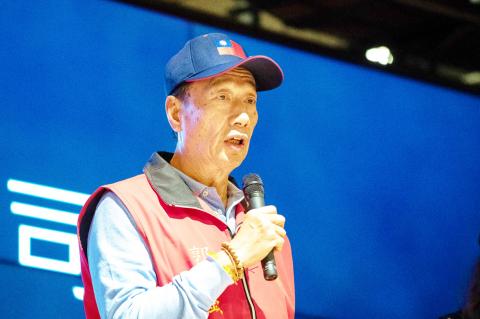Hon Hai Precision Industry Co (鴻海精密), known internationally as Foxconn Technology Group (富士康科技集團), is within weeks of starting trial production of the latest iPhones in India as Apple Inc seeks to revive its fortunes in the country, people familiar with the matter said.
The trial run of the iPhone X range of devices would come before Foxconn starts full-scale assembly at its factory outside the southern Indian city of Chennai, the people said, asking not to be identified as the plans are private.
Wistron Corp (緯創) already produces older models, such as the iPhone 6s, iPhone SE and iPhone 7, at a plant in Bengaluru, India.

Photo: Bloomberg
Apple has become a minor player in India with about 1 percent of the country’s shipments, as its higher prices deter customers in the world’s fastest-growing major market.
Production in India would help the Cupertino, California-based company avoid import duties of 20 percent and also meet a 30 percent local sourcing rule that would allow it to open its own stores in the country.
“Seen from Cupertino. the India market looks minuscule, so Apple’s strategy has been myopic,” Counterpoint Research director of research Neil Shah said. “They haven’t capitalized on the ground potential — India will cross a half-billion smartphone users this year.”
As Apple’s market share declines in China and a US-China trade dispute heats up, the US company needs to diversify into India.
“Apple no longer wants to keep all its eggs in one basket,” Shah said.
Indians last year bought more than 140 million smartphones, with just 1.7 million sold by Apple, as consumers favored cheaper models from China.
On Xiaomi Corp’s (小米) Indian Web site, the Redmi Note 7 has a price of 9,999 rupees (US$145), one-10th the price of Apple’s iPhone Xs in the country.
In the first two months of this year, Apple shipped about 150,000 devices in India and is likely to see an about 50 percent drop in the quarter ended last month from the year earlier, Shah said.
A spokeswoman for Apple did not respond to e-mailed questions about India production.
Foxconn did not immediately respond to an e-mail seeking comment.
Hon Hai’s Indian assembly line would serve local and export markets by the time Apple announces its next iPhone models in September, the sources said.
The Taiwanese contract manufacturer, the biggest maker of iPhones, would initially invest about US$300 million to set up for Apple, with investments to ramp up as capacity expands, they said.
Foxconn has two assembly sites in the southern states of Andhra Pradesh and Tamil Nadu, where it makes devices for Xiaomi and Nokia Corp.
Locating more production in India would also help diversify Apple and Foxconn’s manufacturing footprint away from China amid the ongoing trade tensions with the US.
In December last year, the Hindu newspaper reported that Foxconn would make iPhones at the Chennai plant this year, citing an announcement at a Cabinet meeting led by Tamil Nadu Chief Minister Edappadi Palaniswami.

GROWING OWINGS: While Luxembourg and China swapped the top three spots, the US continued to be the largest exposure for Taiwan for the 41st consecutive quarter The US remained the largest debtor nation to Taiwan’s banking sector for the 41st consecutive quarter at the end of September, after local banks’ exposure to the US market rose more than 2 percent from three months earlier, the central bank said. Exposure to the US increased to US$198.896 billion, up US$4.026 billion, or 2.07 percent, from US$194.87 billion in the previous quarter, data released by the central bank showed on Friday. Of the increase, about US$1.4 billion came from banks’ investments in securitized products and interbank loans in the US, while another US$2.6 billion stemmed from trust assets, including mutual funds,

Micron Memory Taiwan Co (台灣美光), a subsidiary of US memorychip maker Micron Technology Inc, has been granted a NT$4.7 billion (US$149.5 million) subsidy under the Ministry of Economic Affairs A+ Corporate Innovation and R&D Enhancement program, the ministry said yesterday. The US memorychip maker’s program aims to back the development of high-performance and high-bandwidth memory chips with a total budget of NT$11.75 billion, the ministry said. Aside from the government funding, Micron is to inject the remaining investment of NT$7.06 billion as the company applied to participate the government’s Global Innovation Partnership Program to deepen technology cooperation, a ministry official told the

AI TALENT: No financial details were released about the deal, in which top Groq executives, including its CEO, would join Nvidia to help advance the technology Nvidia Corp has agreed to a licensing deal with artificial intelligence (AI) start-up Groq, furthering its investments in companies connected to the AI boom and gaining the right to add a new type of technology to its products. The world’s largest publicly traded company has paid for the right to use Groq’s technology and is to integrate its chip design into future products. Some of the start-up’s executives are leaving to join Nvidia to help with that effort, the companies said. Groq would continue as an independent company with a new chief executive, it said on Wednesday in a post on its Web

Taiwan Semiconductor Manufacturing Co (TSMC, 台積電), the world’s leading advanced chipmaker, officially began volume production of its 2-nanometer chips in the fourth quarter of this year, according to a recent update on the company’s Web site. The low-key announcement confirms that TSMC, the go-to chipmaker for artificial intelligence (AI) hardware providers Nvidia Corp and iPhone maker Apple Inc, met its original roadmap for the next-generation technology. Production is currently centered at Fab 22 in Kaohsiung, utilizing the company’s first-generation nanosheet transistor technology. The new architecture achieves “full-node strides in performance and power consumption,” TSMC said. The company described the 2nm process as